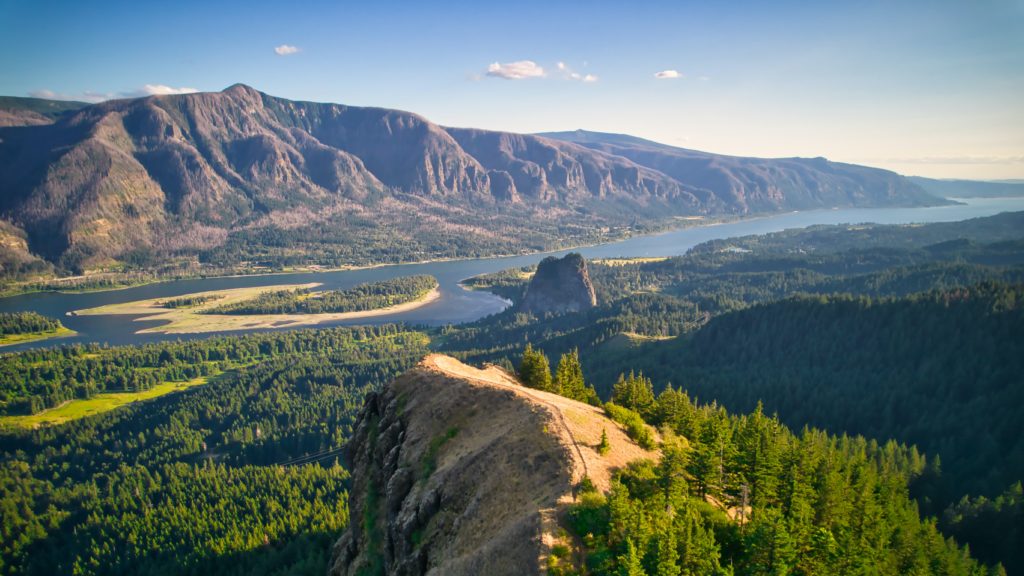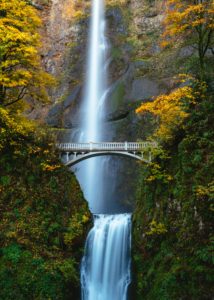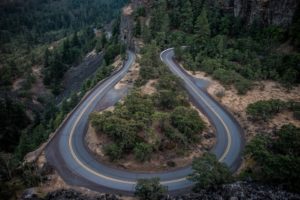The Lewis and Clark National Historic Trail works with over 900 partners nationwide, ranging from government agencies to non-profit organizations to small and local businesses. The Columbia Gorge Tourism Alliance (CGTA), headed by Network Director, Emily Reed, is a proud partner of the Lewis and Clark National Historic Trail, aligned in their goals to uplift local economies and protect natural resources. Primarily based in Washington and Oregon, the CGTA focuses on enhancing sustainable tourism within the region by bringing together an expansive network of stakeholders to improve infrastructure and promote inclusive and collaborative tourism agendas. In today’s blog, Ethan Bollert interviews Emily Reed about the region itself, the challenges and changes facing the tourism industry, and the CGTA’s framework for sustainable travel and geotourism.

The Columbia River Gorge from above
Could you give a brief introduction to yourself and your background leading up to your role at the Columbia Gorge Tourism Alliance?
“I’m Emily Reed. I work with the Columbia Gorge Tourism Alliance as the Network Director. I have a background in brand strategy, so about 20 years in different brands all over the US and then longer stints in Australia and New York. But I am from the Gorge originally. I also had about 10 years working with what would essentially be networks, so a flat structure of people. Not a hierarchy, but people coming together as a group to create something – a project or an event, or what have you. That is very much the case with our network here. Our network is about a flat structure.”
Can you describe the Columbia Gorge and the goals of the Tourism Alliance?
“The Gorge is a National Scenic Area. It spans across two states, six different counties, and several towns. It is a gorgeous area that is protected, but also includes these towns. The key is balancing the needs of the people living in the towns with the need to protect the beautiful scenery. It is an ecosystem that is always being managed. We have Multnomah falls, which receives 2 million people a year. It’s within an incredible waterfall corridor. There’s an old highway that winds through several different waterfalls where you can get out and look around. That whole area is really seeing the pressures of that visitation. I want to say 80% of the visitors to the Gorge visit 20% of the places. We work as an entire region to spread out that congestion and protect the areas so that they don’t get over loved”

Multnomah Falls
How do you market the towns and experiences within the Columbia Gorge region to people who might be more drawn to more traditional tourism experiences such as big cities or National Parks?
“One of the things that we have decided as a region is that we’re not particularly marketing ourselves, we’re being discovered. We’re helping people who come visit to understand how best to visit, and how best to understand our culture. We don’t really market. If you were to talk about the highlights of the towns, there’s a lot of amazing local food, a lot of wine, great wineries and breweries. There’s a rich, local food culture. There’s a thing called Hike-O-Clock, where people go for a hike, and they come back and have a beer. So, from Towns to Trails, the towns and local businesses are integrated into the experiences of hiking and outdoor recreation. You can’t really separate the two. There’s a culture that we’re protecting and letting people know how to protect our culture as well.”
Geotourism is defined as “tourism that sustains or enhances the distinctive geographical character of a place—its environment, heritage, aesthetics, culture, and the well-being of its residents.” How do you think this ‘travel like a local’ approach to tourism can benefit both the locals and the tourists themselves?
“That’s exactly what we are doing with our network. The focus of our network is to weave those elements together, instead of seeing them as separate. For example, we have the food trail, which highlights places where you can get at least 25% local food within the restaurants or the wineries. Or the farms you can tour to see how the food is raised. That supports our local food system and gives the visitor a unique taste of the area. It also spreads out the congestion and pulls people from our hotspots. Another example is our “Ready Set Gorge” website, which is designed to teach people how to be safe in the outdoors, so they don’t get hurt on the trails, but also how they don’t hurt the trails. That website really encourages folks to support our local businesses and get out and give some economic benefit to our towns.”

Local Columbia Gorge cuisine
Many organizations originate as a ‘Destination Marketing Organization’ and gradually shift to being a ‘Destination Management Organization’ (DMO). Is this the case for the CGTA? If so, what does that change look like?
“The Columbia Gorge Tourism Alliance was formed in 2016 for that very reason. We have several partners on our board and within our network who don’t have a historical tourism focus. We have the Oregon Department of Transportation; we have the economic district; we have the tribes. We have several folks that wouldn’t be associated with tourism traditionally mixed in with those that are. We have eight different DMOs that are part of our network. This group joined together in order to look at the region as a whole, not just for promotion. Previously, there was a tourism alliance, but that organization was primarily for promotion. The shift [toward destination management] happened in 2016. We used the network model as a way of really being able to get all the voices within our region to work together.”
How does the CGTA combat the challenges of working with such a large network of different stakeholders?
“Our mission is very clear, and the needs of the region are very clear. That allows our wide range of partners to work together. For example, in the pandemic we have two different states. They’re both on different timelines for opening to visitors. We wanted to avoid one town saying, “come on out” while the other town is saying, “please stay away.” So, we had bi-week meetings with the entire region. We developed a four-level phase communication chart. We could then all agree on what phase we were in and we all put out the messages at the same time. This is where people came to visit, and it really created a lot of stress to our trails and towns. When we were able to speak together to say, “whoa, not yet,” we were able to speak in a unified voice and people respected that until we were ready.”
The new generation of younger travelers seems to be very passionate about the idea of sustainable travel. How do you capitalize on this and ensure that tourism around the Gorge is sustainable?
“We are really focused on establishing a car-free transportation system. A coordinated bus system is in the works and has grown amazingly within the last three to five years. Our end goal is to create something that is easy, accessible, and timely so that it’s easier to use than taking a car. We’re also just a few years away from being 100% able to bike from Portland all the way to the Dalles. Once that last mile of bike path is complete that’s going to be huge and an amazing experience. We also do have a strong Native American history in the area and we work very closely with the tribes to make sure that we are not promoting anything that they do not like. We want to make sure we are serving their interests in terms of what they’d like to open and what they don’t want to open.”

Rowena Crest Viewpoint
Where do you want to see the tourism industry in the Columbia Gorge region 10 years from now?
“I would love for our sustainable tourism strategies to be broadly shared by all. I would love the entire culture and people of our region to speak to those values and be able to share those with anyone that they meet. So that the job of management is not done by a handful of people but is shared by locals as well. Visitors can then understand how to be here in a way that is good for the region. The capacity for folks in our region to work together is really high. There’s a strong, shared understanding in the region that being able to get together and share what’s happening is a huge benefit. We see this beyond even our tourism network, but in a lot of different industries as well.”
In your opinion, what are the essential spots that someone interested in visiting the Columbia Gorge should check out?
“I would say go to Multnomah Falls car free. Explore one of the amazing trails in the area and then go visit the nearest town for local food – I would say go east. There are amazing experiences in the eastern part that are ready to be discovered, including the Maryhill Museum of Art. I would also urge everyone to try the Native American salmon because this area is one of the few places that you can buy fresh or smoked salmon directly from Native Americans in a way that really supports their culture. Lastly, go to Columbia Hills State Park. Not only do you have a gorgeous place to swim, but there is also a historic campsite of Lewis and Clark. There are even petroglyphs and pictographs from the local Native American tribes. You can sign up for a free guided tour to see the “she who watches” petroglyph, which is world-famous.”
Thank you for reading this interview with CGTA Network Director, Emily Reed, as she expanded upon the organization’s goals to promote sustainable tourism practices that prioritize not only the natural environment, but the best interests of the region’s residents. Remember to be mindful of your travel practices and consider the ‘travel like a local’ approach!
